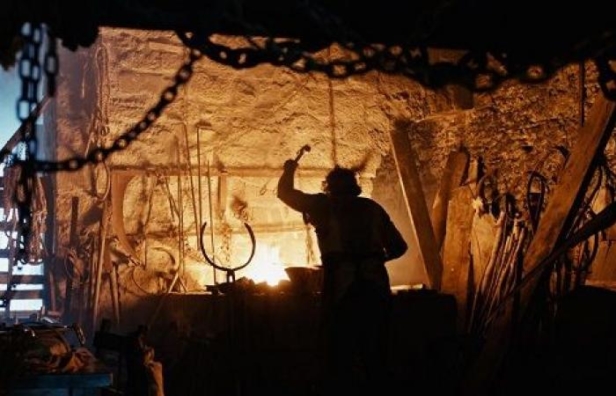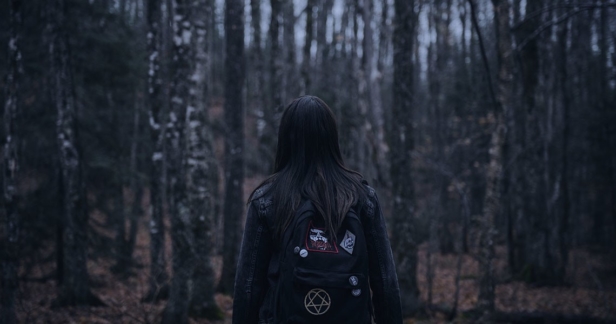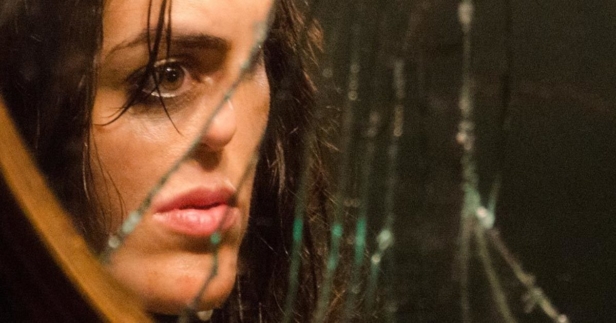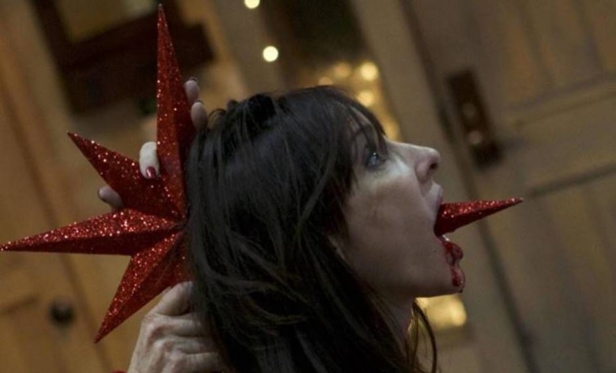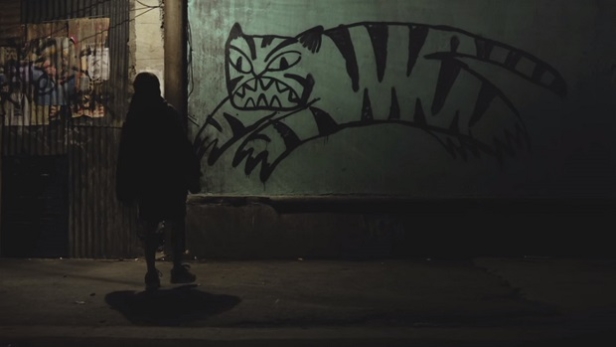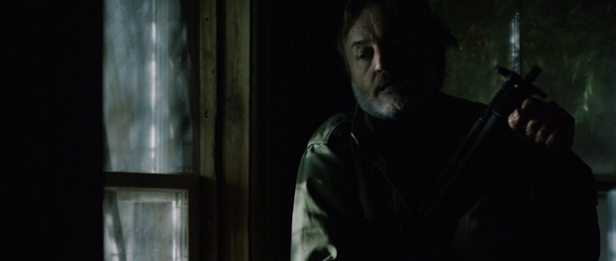The Blacksmith And The Devil (Errementari)
“Do you believe in Hell?” asks the narrator at the beginning of The Blacksmith And The Devil over a red-lit animated version of the infernal realm, before promising a tale of “a man so cruel that even the devil himself would fear him – a blacksmith.”
Now it is relatively easy to confuse a blacksmith with a devil. After all, they both deal in forges and flames, and the tools of their trade are more or less the same. In 1835, during the first Carlist War, a blacksmith named Patxi (Kandido Uranga) miraculously escapes (and slaughters) a government firing squad in Álava province. Eight years later, nicknamed ‘The Hammer’ for his tool (and weapon) of choice, he lives as a recluse in the well-fortified and booby-trapped ruins of his smithy, the subject of endless gossip and speculation among suspicious locals. This is a nation still divided between its older religious/cultural traditions and a reforming, liberal administration (“avaricious bourgeois fornicators”, as the Catholic priest calls them). Occupying the faultlines of these tensions is Patxi, believed to be a wife-murdering, child-snatching devil even as he contributes to the rebuilding of the war-damaged village and church. Meanwhile two people converge on the smithy – provincial official Alfredo (Ramón Aguirre) seeking to reclaim lost war spoils, and bullied local orphan Usue (Uma Bracaglia) looking for her missing doll. What they find there is the hulking Patxi, dressed in home-forged armour like Ned Kelly, and a hapless prisoner (Eneko Sagardoy) kept in a hanging cage. In the mess of misunderstandings, clashes and double-dealings that ensue, there will be one hell of a final reckoning, on earth and below.
Based loosely on a Basque folktale, director/co-writer Paul Urkijo Alijo’s feature debut offers us a contradictory character, and sets out on a paradoxical path, satirising smalltown superstition while also affirming its wildest imaginings to be true. For here the devil works in mysterious ways, masks are not just for the wicked, and the vicissitudes of war make monsters of everyone. In a series of energetically managed and often very funny reversals, Alijo keeps confounding our grip on good and evil, as notions of heroism and villainy prove very slippery – and, in the dangerous environment of the smithy, any false step can lead to injury or death. With fantastic set designs and beautifully sombre lighting, The Blacksmith And The Devil transforms nineteenth-century northern Spain into a space all at once mythic and medieval, and stages there a morality drama that might ring some bells for anybody who has ever felt conflicted by life’s complexities – or been taken in by a story.
Pyewacket
“I wish you were dead!”, Leah Reyes (Nicole Muñoz) shouts – like the blazing teenager that she is – but her words recede in the unheeding forest which she has entered alone.
The focus of Leah’s unrestrained rage is her mother (Laurie Holden) who, still in emotional freefall from the recent death of her husband, has drifted into alcoholism, and constantly lashes out at her daughter. Meanwhile Leah is having to negotiate the travails of adolescence as well as her own sense of bereavement, and uses a newfound interest in the occult as a way both to rebel and to process her feelings about death. Her already fraught relationship with her mother is pushed further when Mrs Reyes, now feeling suffocated in their once happy suburban home, decides to sell it and move them both out to a remote house by the woods, uprooting the fragile new friendships that Leah has been forming at school. After an unkind exchange of words, Leah heads out to the autumnal trees and amateurishly enacts a ritual from one of her books, summoning the wicked spirit Pyewacket to punish her mother with death – and even when, shortly afterwards, the younger and older woman have made up, and Leah has started settling into her life on the town’s margins, the teen becomes convinced that something dark and malevolent is entering the house at night with wicked designs on both her mother and herself.
“I can’t believe you wanted to kill your own mother,” says Leah’s gothy schoolfriend Rob.”That’s the scary part. I mean, why?” It is a question that cuts to the thematic heart of Pyewacket. For Leah’s impromptu ritual is an expression of the intensity of her adolescent anger, resentment and fantasies of empowerment – and as such, it is also a rite of passage, revealing something of her character’s transgressive willingness to test the precarious borderlands between reason and superstition, between love and hate, and between modern civilisation and primeval wilderness. Accordingly the film, like writer/director Adam MacDonald’s previous Backcountry (2014), deploys menacing woodland gothic as the staging ground for more psychological concerns – in this case the dysfunctional bond between a mother and daughter beleaguered by grief, loss and recrimination.
If you are fed up with studio-produced horror films that insist on having a gratuitous jump scare every 5 or 10 minutes, then Pyewacket is your antidote – an insidious slow burn that from the start deploys sinuous tracking shots to evoke either dreamy dissociation or a disembodied, predatory presence, and carefully builds to a climax that is as harrowingly tragic and emotionally honest as it is frightening. For whatever it is that Leah has conjured with her words and her will, it will not be easily dispelled – and some demons are best left buried.
Friendly Beast (O Animal Cordial)
“It’s raw,” complains Veronica (Camila Morgado) of the pink piece of wild boar’s meat that oozes blood on the fork. “I ordered it medium.”
Friendly Beast (O Animal Cordial), the feature debut of Brazilian writer/director Gabriela Amaral Almeida, is full of raw appetites, animalistic behaviours and bloody carnality, as a violent attempted robbery at a restaurant, La Barca, leads the owner Inácio (Murilo Benício) and his waitress Sara (Luciana Paes) to lay aside normal rules and, over the course of one long night, to indulge their most bestial impulses.
Right from its subtly animated opening credits that show red-lit diagrams of human anatomy, there is the sense that Friendly Beast will be a study of what constitutes the human animal, even if the laboratory in which this study is to take place will be a small dining room, kitchen, back corridor and toilet, all shot with a claustrophobic tightness. “Wish hard and it will happen,” Inácio tells Sara when she expresses her hope that the last diner (Ernani Moraes) will eat quickly. “Whatever you want,” Sara’s coworker Lúcio (Diego Avelino) tells her, flirtatiously describing what they can do together after closing up. Desire – Sara’s desire – is in the air, but she has eyes only for her boss, and indeed will do anything for him, even if it means staying late for two late-arriving customers, the condescending Veronica and her husband Bruno (Jiddú Pinheiro). Meanwhile Inácio, ambitious and under pressure to improve the status of his restaurant, conceals beneath his forced smile a frustration with life’s petty humiliations and a seething anger towards everyone around him. “Food is art,” he says to himself in the bathroom mirror, practising both his interview technique (for a coming magazine article) and his false bonhomie – but the real artist is in fact the chef, black, queer Djair ( (Irandhir Santos), who cooks all the food, keeps the peace and is in love with life. “What do you want out of life?”, Djair will later ask Sara – and she will need to work out the answer in a closed world whose realities are more disappointing than fantasy.
Into this hotbed of contained passions come two young would-be thieves (Humberto Carrão, Ariclenes Barroso), whose armed, rape-happy arrival triggers something in the indignant Inácio. That something will quickly spiral out of control, transforming this place of fleshy consumption into a domain where a new menu may now be drawn up to satisfy Inácio’s own – and perhaps Sara’s – hidden hungers. As these two strip their inhibitions to the bone, we witness an increasingly messy descent into untethered psychosis and irrational animality. For in Friendly Beast, food ultimately is art, the carving of red meat is all, and sex and death are dishes served very bloody. Human horror this confronting is rare indeed.
Secret Santa
After a prologue which shows a family literally at one another’s throats in a Christmas get-together gone horribly, bloodily wrong, Secret Santa cuts to four hours earlier, as the different members of the extended Pope family and their various partners and hangers-on descend on the home of ghastly matriarch Shari (co-writer Debra Sullivan), all nervous about the annual petty squabbles but oblivious to the murderous mayhem to come. The opening credits first state the names of the cast and crew, before effacing some letters to reveal hidden words contained within (‘die’, ‘lies’, ‘kill the rat’, ‘lynch’, ‘dead’, etc.). It is an economic way of introducing the dark impulses and emotions simmering below the surface of this bourgeois clan.
Shari’s favourite daughter, recovering alcoholic April (A Leslie Kies), has planned, as a gesture of goodwill, to bring everyone – even Shari’s estranged husband Leonard (John Gilbert) – together for a grand reconciliation and some home truths. Little does she know, however, that someone has parallel plans of a more malicious kind for the evening, and has drugged the drink, bringing out everyone’s dark ids, personal hatreds and a lot of the old ultraviolence, not to mention the most jaw-droppingly ugly non-PC views (racism, antisemitism, homophobia, misogyny, etc.) that have barely been concealed beneath their monied gentility. The ensuing chaos turns up to 11 the kind of dysfunction common to many a Yuletide gathering, while inverting the tropes of the typical Santa slasher (since here, everyone is a killer).
Writer/director Adam Marcus has previously brought us the calendar horror of Jason Goes To Hell: The Final Friday (1993) and the wintry rom com of Let It Snow (1999) – and so, with Secret Santa, he combines the two in a snowy splatterfest that repeatedly plays upon the discrepancy between the supposedly seasonal joy of Christmas, and the seething aggressions and resentments that brew underneath. Filled with horrible humans meeting equally horrible ends, this is a vicious black comedy that packs one hell of a punch.
Tigers Are Not Afraid (Vuelven) (2017)
“What if I used my last wish to make Chino disappear?”
“There are no wishes. There’s nothing. Not even tigers.”
This exchange between idealistic, imaginative Estrella (Paola Lara) and cynical, despairing Shine (Juan Ramós López) captures a dialectic that is ongoing in Issa López’s Tigers Are Not Afraid (aka Vuelven, literally ‘return’), a film that constantly interweaves fact and fantasy through the storytelling mode known as magical realism. For Tigers Are Not Afraid begins with a set of factual figures about the casualties in Mexico’s Drug War, and ends with an idyllic scene of pure creativity – and in between, we watch Estrella, Shine and other children processing through the filter of myth and animism the horror of their all-too-real experiences.
In the film’s opening, programmatic scene, young Estrella is in a classroom where the pupils are being encouraged to fashion their own stories through a recombination of fairytale archetypes and motifs. The lesson is violently cut short by a burst of gunfire outside that has the whole class ducking on the floor. There, the kindly teacher calms Estrella by handing her three pieces of chalk which she says will grant the girl three wishes. Estrella will then narrate her own life story – orphaned after the gang of local would-be politician Chino (Tenoch Huerta) kills her mother – as though it were a children’s fiction. Estrella’s point of view on events is doubly determined, showing not only the harsh reality of her life on the streets of new Mexico with other young victims of cartel violence, but also a phantasmagorical world of animated graffiti, revenant dead, flying dragons, living plush toys and snaking rivulets of blood. Rather than one of these perspectives being correct and the other childish delusion, both must be synthesised to follow the story from beginning to bittersweet end.
Comparisons to Pan’s Labyrinth (2006) are inevitable, but where fellow Mexican Guillermo del Toro’s film used the Spanish Civil War as a broader reflex for other authoritarian power structures (including the Bush era in which it was made), López’s film is much more direct in its contemporary concerns, unfolding as it does in an all-too-recognisable Mexico of today, and using the furnishings of fantasy to turn unimaginable Drug War reality into something that the viewer can find conceivable, if not quite palatable. The results are all at once disturbing and profoundly moving, as Shine’s pragmatic nihilism and Estrella’s haunted escapism merge into a conflicted vision of the unconscionable. As for the tigers, they are a multivalent symbol of princeliness and predation, of entrapment and escape, and their presence in the film variously as spray-painted illustrations, as stuffed toys, and as living, breathing creatures of the imagination ensures that López’s astonishing, beautiful film remains a state-of-the-nation allegory of a different stripe.
Sixty Minutes To Midnight
Aptly counting down to the end of this year’s Glasgow FrightFest is the weekend’s closer, Sixty Minutes To Midnight – a low-budget labour of love whose Canadian director, Neil Mackay, also serves as editor and cinematographer, while managing a cast of mostly first-time actors. Mackay’s feature debut Battleground (2012) concerned a deranged Vietnam vet picking off armed robbers in Michigan forestland as though he were still fighting guerrilla warfare in the jungles of Indochina. In certain respects, the premise of this latest film is similar – although there are significant differences too.
In Wheeler, Texas on 31 December, 1999, Jack Darcy (Robert Nolan) – also, like the vet in Battleground, originally from Michigan – is a working-class, middle-aged man on the edge. One of his old Vietnam buddies has just dropped dead of a heart attack while mowing the lawn, and Jack’s thoughts of mortality are compounded by more general pre-millennial anxieties over Y2K and national unrest – and by the fact that he has just quit smoking. After finishing his day shift, Jack prefers to see in the New Year holed up alone in his isolated farmhouse to partying with his workmate Markus (Arnold Sidney). Jack is the kind of man who keeps an arsenal in a secured bunker, who drinks himself to sleep, and who is barely even in contact with his only relative Carol (Marlene Leslie). “I was beginning to think you were a figment of my imagination,” Jack’s sister tells him when she finally gets him on the phone, to which he significantly replies: “Sometimes I wonder if I’m a figment of my own.” Jack is an alcoholic and something of a paranoid fantasist – all of which is to say that this self-reliant right-wing gun-nut loner might turn into the Unabomber, or just happily vote for Trump in 16 years’ time in order to see the swamp cleared.
Or he might not get to live that long. For Jack is woken from his slumber on the sofa to be informed by game show host Bud Carson (Terry McDonald) – addressing Jack directly from the television – that he has been chosen to be the latest contestant in Race the Clock. Over the next 60 minutes, the house comes under attack from military professionals intent on killing him, and the beleaguered Jack must call on killer instincts and resources he had forgotten he had, all the while being subjected intermittently to commercial breaks promoting the cigarettes he so craves. Sixty Minutes To Midnight is a claustrophobic thriller full of bloody action, as one man improbably takes on an army and stands his ground against impossible odds in his home turned war zone. We are, however, always left with the impression – even if it is thankfully never quite spelt out – that we might be bearing witness not to an actual, if irrational, home invasion, but rather to a drunk, unravelling man’s PTSD nightmares. Either way, the film captures the siege mentality of a nation on the cusp of great, potentially violent change. For in Jack’s paranoid conspiracy delusions we see both a foreshadowing of America’s second Vietnam in Iraq, and the makings of today’s electorate – well-armed and convinced that the state’s élites are out to get them.
Thanks to the Horror Channel FrightFest team and everyone at Glasgow Film Festival.
